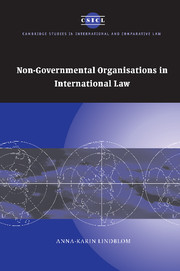Book contents
- Frontmatter
- Contents
- Acknowledgements
- List of abbreviations
- Part I Theoretical framework
- Part II Legal and empirical survey
- 4 Rights and obligations
- 5 Standing before international judicial and quasi-judicial bodies
- 6 Non-party participation before judicial and quasi-judicial bodies
- 7 Co-operation with intergovernmental organisations
- 8 Participation in international conferences
- 9 Agreements with states and intergovernmental organisations
- Part III Conclusion
- Bibliography
- Interviews
- Index
- CAMBRIDGE STUDIES IN INTERNATIONAL AND COMPARATIVE LAW
5 - Standing before international judicial and quasi-judicial bodies
Published online by Cambridge University Press: 12 August 2009
- Frontmatter
- Contents
- Acknowledgements
- List of abbreviations
- Part I Theoretical framework
- Part II Legal and empirical survey
- 4 Rights and obligations
- 5 Standing before international judicial and quasi-judicial bodies
- 6 Non-party participation before judicial and quasi-judicial bodies
- 7 Co-operation with intergovernmental organisations
- 8 Participation in international conferences
- 9 Agreements with states and intergovernmental organisations
- Part III Conclusion
- Bibliography
- Interviews
- Index
- CAMBRIDGE STUDIES IN INTERNATIONAL AND COMPARATIVE LAW
Summary
Introduction
In an article published in 1947, Sir Hersch Lauterpacht observed that: ‘It would thus appear that there is nothing inherent in the structure of international law which prevents individuals and, generally, persons other than States from being parties to proceedings before international tribunals.’ He was right. States are increasingly institutionalising the participation of non-state actors in international proceedings. This is particularly true concerning regional human rights mechanisms.
This chapter contains a description of the extent to which NGOs enjoy such procedural capacity in international law. The survey has two main components. It describes the existence and content of rules which provide some sort of locus standi to NGOs, and it includes a survey of cases instituted by NGOs intended to give a rough outline of the activity of NGOs before international tribunals and quasi-judicial bodies and the types of cases brought by them.
As regards the case-law material, a couple of points need to be explained. First, it has been necessary to limit the number of mechanisms and cases studied, for practical reasons. Secondly, the group of actors which is allowed to institute proceedings under the designation ‘non-governmental organisation’ is differently defined within the different mechanisms, and these definitions do not always correspond to the one adopted in the present study. It would be too time-consuming to investigate whether the particular organisations acting which have filed in the different cases are ‘NGOs’ in the meaning of the term as it has been defined here.
- Type
- Chapter
- Information
- Non-Governmental Organisations in International Law , pp. 218 - 299Publisher: Cambridge University PressPrint publication year: 2006

